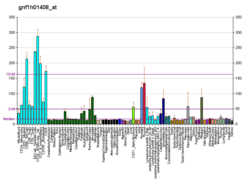PLDN
Pallidin is a protein that in humans is encoded by the PLDN gene.[5][6]
Function
The protein encoded by this gene may play a role in intracellular vesicle trafficking. It interacts with Syntaxin 13 which mediates intracellular membrane fusion. Several alternatively spliced transcript variants of this gene have been described, but the full-length nature of some of these variants has not been determined.[6]
Interactions
PLDN has been shown to interact with:
gollark: Legally, I don't actually *have* veins.
gollark: You are like a polygon made of soyuzite.
gollark: <@236831708354314240> isn't real.
gollark: Stars use fusion, not fission, I mean.
gollark: > The primary food source of SCP-3485 is residue created by stars during fission reactions, such as leftover hydrogen and helium.*Really*?
References
- GRCh38: Ensembl release 89: ENSG00000104164 - Ensembl, May 2017
- GRCm38: Ensembl release 89: ENSMUSG00000005804 - Ensembl, May 2017
- "Human PubMed Reference:". National Center for Biotechnology Information, U.S. National Library of Medicine.
- "Mouse PubMed Reference:". National Center for Biotechnology Information, U.S. National Library of Medicine.
- Huang L, Kuo YM, Gitschier J (Dec 1999). "The pallid gene encodes a novel, syntaxin 13-interacting protein involved in platelet storage pool deficiency". Nat Genet. 23 (3): 329–32. doi:10.1038/15507. PMID 10610180.
- "Entrez Gene: PLDN pallidin homolog (mouse)".
- Starcevic M, Dell'Angelica EC (Jul 2004). "Identification of snapin and three novel proteins (BLOS1, BLOS2, and BLOS3/reduced pigmentation) as subunits of biogenesis of lysosome-related organelles complex-1 (BLOC-1)". J. Biol. Chem. 279 (27): 28393–401. doi:10.1074/jbc.M402513200. PMID 15102850.
- Falcón-Pérez JM, Starcevic M, Gautam R, Dell'Angelica EC (Aug 2002). "BLOC-1, a novel complex containing the pallidin and muted proteins involved in the biogenesis of melanosomes and platelet-dense granules". J. Biol. Chem. 277 (31): 28191–9. doi:10.1074/jbc.M204011200. PMID 12019270.
Further reading
- Falcón-Pérez JM, Dell'Angelica EC (2002). "The pallidin (Pldn) gene and the role of SNARE proteins in melanosome biogenesis". Pigment Cell Res. 15 (2): 82–6. doi:10.1034/j.1600-0749.2002.1r082.x. PMID 11936273.
- Korsgren C, Cohen CM (1988). "Associations of human erythrocyte band 4.2. Binding to ankyrin and to the cytoplasmic domain of band 3". J. Biol. Chem. 263 (21): 10212–8. PMID 2968981.
- Azim AC, Marfatia SM, Korsgren C, Dotimas E, Cohen CM, Chishti AH (1996). "Human erythrocyte dematin and protein 4.2 (pallidin) are ATP binding proteins". Biochemistry. 35 (9): 3001–6. doi:10.1021/bi951745y. PMID 8608138.
- Andersson B, Wentland MA, Ricafrente JY, Liu W, Gibbs RA (1996). "A "double adaptor" method for improved shotgun library construction". Anal. Biochem. 236 (1): 107–13. doi:10.1006/abio.1996.0138. PMID 8619474.
- Risinger MA, Korsgren C, Cohen CM (1997). "Role of N-myristylation in targeting of band 4.2 (pallidin) in nonerythroid cells". Exp. Cell Res. 229 (2): 421–31. doi:10.1006/excr.1996.0387. PMID 8986625.
- Yu W, Andersson B, Worley KC, Muzny DM, Ding Y, Liu W, Ricafrente JY, Wentland MA, Lennon G, Gibbs RA (1997). "Large-scale concatenation cDNA sequencing". Genome Res. 7 (4): 353–8. doi:10.1101/gr.7.4.353. PMC 139146. PMID 9110174.
- Falcón-Pérez JM, Starcevic M, Gautam R, Dell'Angelica EC (2002). "BLOC-1, a novel complex containing the pallidin and muted proteins involved in the biogenesis of melanosomes and platelet-dense granules". J. Biol. Chem. 277 (31): 28191–9. doi:10.1074/jbc.M204011200. PMID 12019270.
- Moriyama K, Bonifacino JS (2003). "Pallidin is a component of a multi-protein complex involved in the biogenesis of lysosome-related organelles". Traffic. 3 (9): 666–77. doi:10.1034/j.1600-0854.2002.30908.x. PMID 12191018.
- Ciciotte SL, Gwynn B, Moriyama K, Huizing M, Gahl WA, Bonifacino JS, Peters LL (2003). "Cappuccino, a mouse model of Hermansky-Pudlak syndrome, encodes a novel protein that is part of the pallidin-muted complex (BLOC-1)". Blood. 101 (11): 4402–7. doi:10.1182/blood-2003-01-0020. PMID 12576321.
- Li W, Zhang Q, Oiso N, Novak EK, Gautam R, O'Brien EP, Tinsley CL, Blake DJ, Spritz RA, Copeland NG, Jenkins NA, Amato D, Roe BA, Starcevic M, Dell'Angelica EC, Elliott RW, Mishra V, Kingsmore SF, Paylor RE, Swank RT (2003). "Hermansky-Pudlak syndrome type 7 (HPS-7) results from mutant dysbindin, a member of the biogenesis of lysosome-related organelles complex 1 (BLOC-1)". Nat. Genet. 35 (1): 84–9. doi:10.1038/ng1229. PMC 2860733. PMID 12923531.
- Starcevic M, Dell'Angelica EC (2004). "Identification of snapin and three novel proteins (BLOS1, BLOS2, and BLOS3/reduced pigmentation) as subunits of biogenesis of lysosome-related organelles complex-1 (BLOC-1)". J. Biol. Chem. 279 (27): 28393–401. doi:10.1074/jbc.M402513200. PMID 15102850.
- Stelzl U, Worm U, Lalowski M, Haenig C, Brembeck FH, Goehler H, Stroedicke M, Zenkner M, Schoenherr A, Koeppen S, Timm J, Mintzlaff S, Abraham C, Bock N, Kietzmann S, Goedde A, Toksöz E, Droege A, Krobitsch S, Korn B, Birchmeier W, Lehrach H, Wanker EE (2005). "A human protein-protein interaction network: a resource for annotating the proteome". Cell. 122 (6): 957–68. doi:10.1016/j.cell.2005.08.029. hdl:11858/00-001M-0000-0010-8592-0. PMID 16169070.
This article is issued from Wikipedia. The text is licensed under Creative Commons - Attribution - Sharealike. Additional terms may apply for the media files.





